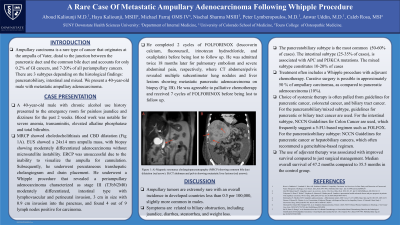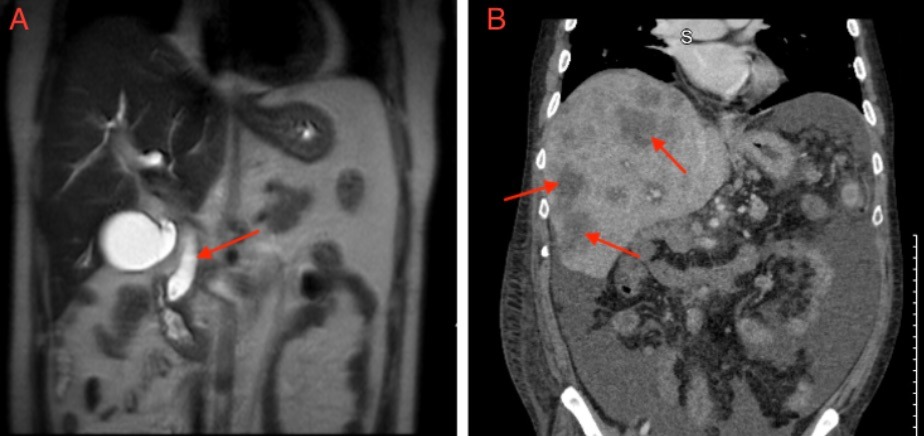Sunday Poster Session
Category: Biliary/Pancreas
P0109 - A Rare Case of Metastatic Ampullary Adenocarcinoma Following Whipple Procedure
Sunday, October 22, 2023
3:30 PM - 7:00 PM PT
Location: Exhibit Hall

Has Audio

Aboud Kaliounji, MD
SUNY Downstate Health Sciences University
Brooklyn, NY
Presenting Author(s)
Aboud Kaliounji, MD1, Haya Kaliounji, BS2, Michael Farraj, BS3, Nischal Sharma, BS1, Peter Lymberopoulos, MD1, Anwar Uddin, MD1, Caleb Rosa, BA2
1SUNY Downstate Health Sciences University, Brooklyn, NY; 2University of Colorado Anschutz Medical Campus, Aurora, CO; 3Touro College of Osteopathic Medicine, Middletown, NY
Introduction: Ampullary carcinoma is a rare type of cancer that originates at the ampulla of Vater, distal to the junction between the pancreatic duct and the common bile duct (CBD) and accounts for only 0.2% of gastrointestinal cancers, and 7-20% of all periampullary cancers. We present a 40-year-old male with metastatic ampullary adenocarcinoma.
Case Description/Methods: A 40-year-old male with chronic alcohol use history presented to the emergency room for painless jaundice and dizziness for the past 2 weeks. Blood work was notable for severe anemia, transaminitis, elevated alkaline phosphatase and total bilirubin. MRCP showed choledocholithiasis and CBD dilatation (Fig 1A). Endoscopic ultrasound showed a 24x14 mm ampulla mass, with biopsy showing moderately differentiated adenocarcinoma without microsatellite instability. ERCP was unsuccessful due to the inability to visualize the ampulla for cannulation. Subsequently, he underwent percutaneous transhepatic cholangiogram and drain placement. He underwent a Whipple procedure that revealed a periampullary adenocarcinoma characterized as stage III (T3bN2M0) moderately differentiated, intestinal type with lymphovascular and perineural invasion, 3 cm in size with 0.9 cm invasion into the pancreas, and found 4 out of 9 lymph nodes positive for carcinoma. He completed 2 cycles of FOLFORINOX (leucovorin calcium, fluorouracil, irinotecan hydrochloride, and oxaliplatin) before being lost to follow up. He was admitted twice 18 months later for pulmonary embolism and severe abdominal pain, respectively, where CT abdomen/pelvis revealed multiple subcentimeter lung nodules and liver lesions showing metastatic pancreatic adenocarcinoma on biopsy (Fig 1B). He was agreeable to palliative chemotherapy and received 7 cycles of FOLFORINOX before being lost to follow up.
Discussion: Ampullary tumors are extremely rare with an overall incidence in developed countries less than 0.5 per 100,000. Patients commonly present with symptoms related to biliary obstruction, including jaundice, diarrhea, steatorrhea, and weight loss. There are 3 subtypes depending on the histological findings: pancreatobiliary, intestinal and mixed. Treatment often includes a Whipple procedure with adjuvant chemotherapy. However, despite modern advances in cancer research, there remains an absence of evidence-based treatment standards, which highlights the importance of this case and brings awareness to clinicians about the risk of metastasis to multiple organs following surgical removal.

Disclosures:
Aboud Kaliounji, MD1, Haya Kaliounji, BS2, Michael Farraj, BS3, Nischal Sharma, BS1, Peter Lymberopoulos, MD1, Anwar Uddin, MD1, Caleb Rosa, BA2. P0109 - A Rare Case of Metastatic Ampullary Adenocarcinoma Following Whipple Procedure, ACG 2023 Annual Scientific Meeting Abstracts. Vancouver, BC, Canada: American College of Gastroenterology.
1SUNY Downstate Health Sciences University, Brooklyn, NY; 2University of Colorado Anschutz Medical Campus, Aurora, CO; 3Touro College of Osteopathic Medicine, Middletown, NY
Introduction: Ampullary carcinoma is a rare type of cancer that originates at the ampulla of Vater, distal to the junction between the pancreatic duct and the common bile duct (CBD) and accounts for only 0.2% of gastrointestinal cancers, and 7-20% of all periampullary cancers. We present a 40-year-old male with metastatic ampullary adenocarcinoma.
Case Description/Methods: A 40-year-old male with chronic alcohol use history presented to the emergency room for painless jaundice and dizziness for the past 2 weeks. Blood work was notable for severe anemia, transaminitis, elevated alkaline phosphatase and total bilirubin. MRCP showed choledocholithiasis and CBD dilatation (Fig 1A). Endoscopic ultrasound showed a 24x14 mm ampulla mass, with biopsy showing moderately differentiated adenocarcinoma without microsatellite instability. ERCP was unsuccessful due to the inability to visualize the ampulla for cannulation. Subsequently, he underwent percutaneous transhepatic cholangiogram and drain placement. He underwent a Whipple procedure that revealed a periampullary adenocarcinoma characterized as stage III (T3bN2M0) moderately differentiated, intestinal type with lymphovascular and perineural invasion, 3 cm in size with 0.9 cm invasion into the pancreas, and found 4 out of 9 lymph nodes positive for carcinoma. He completed 2 cycles of FOLFORINOX (leucovorin calcium, fluorouracil, irinotecan hydrochloride, and oxaliplatin) before being lost to follow up. He was admitted twice 18 months later for pulmonary embolism and severe abdominal pain, respectively, where CT abdomen/pelvis revealed multiple subcentimeter lung nodules and liver lesions showing metastatic pancreatic adenocarcinoma on biopsy (Fig 1B). He was agreeable to palliative chemotherapy and received 7 cycles of FOLFORINOX before being lost to follow up.
Discussion: Ampullary tumors are extremely rare with an overall incidence in developed countries less than 0.5 per 100,000. Patients commonly present with symptoms related to biliary obstruction, including jaundice, diarrhea, steatorrhea, and weight loss. There are 3 subtypes depending on the histological findings: pancreatobiliary, intestinal and mixed. Treatment often includes a Whipple procedure with adjuvant chemotherapy. However, despite modern advances in cancer research, there remains an absence of evidence-based treatment standards, which highlights the importance of this case and brings awareness to clinicians about the risk of metastasis to multiple organs following surgical removal.

Figure: Figure 1: A) Magnetic resonance cholangiopancreatography (MRCP) showing common bile duct dilatation (red arrow). B) CT abdomen and pelvis showing metastatic liver lesions (red arrows).
Disclosures:
Aboud Kaliounji indicated no relevant financial relationships.
Haya Kaliounji indicated no relevant financial relationships.
Michael Farraj indicated no relevant financial relationships.
Nischal Sharma indicated no relevant financial relationships.
Peter Lymberopoulos indicated no relevant financial relationships.
Anwar Uddin indicated no relevant financial relationships.
Caleb Rosa indicated no relevant financial relationships.
Aboud Kaliounji, MD1, Haya Kaliounji, BS2, Michael Farraj, BS3, Nischal Sharma, BS1, Peter Lymberopoulos, MD1, Anwar Uddin, MD1, Caleb Rosa, BA2. P0109 - A Rare Case of Metastatic Ampullary Adenocarcinoma Following Whipple Procedure, ACG 2023 Annual Scientific Meeting Abstracts. Vancouver, BC, Canada: American College of Gastroenterology.
